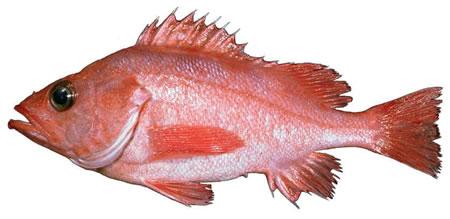Commonly caught off the Washington coast by commercial harvesters using otter-trawls and longline gear.
Description and Range
Physical description
Aurora Rockfish are rose-red to pale pink after capture, resembling both Splitnose and Chameleon Rockfishes. Under water they are white with pale pink to red saddles and blotches on their backs and are silvery on their sides and ventral surface. This species has small hard lobes (dentigerous knobs) that project from the anterior part of the upper jaw, but no prominent upper jaw projections. Aurora Rockfish also have 24-28 gill rakers on the first gill arch.
This species can be differentiated from the Splitnose Rockfish by gill raker count and upper jaw dentigerous knob prominence. Splitnose Rockfish have two very prominent dentigerous knobs with a large indentation between them, whereas Aurora Rockfish have a small upper jaw indentation bordered by reduced knobs. Additionally, Splitnose Rockfish have 32-37 gill rakers on the first gill arch. Chameleon Rockfish often have distinct small red spots within the white blotches on the head and back, while Aurora Rockfish do not have these spots.
Aurora Rockfish can grow up to 41 cm (16 in) in length, and weigh up to 1.1 kg (3.4 lb) or more. The maximum age is at least 118 years old for females, and at least 81 years old for males.
Geographic range
Aurora rockfish are found from Langara Island, British Columbia, to Cedros Island, Baja California. They are a deep water slope species found between 81 and 768 m (267-2,520 ft), and are most abundant from 300 to 500 m (990-1,650 ft). This species has been found over both hard and soft substrates.
